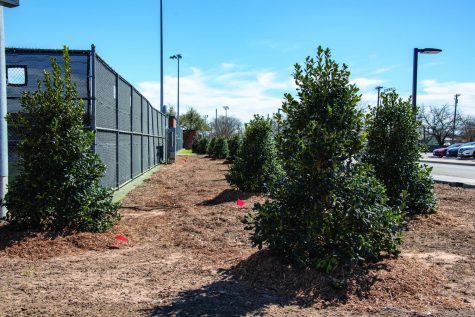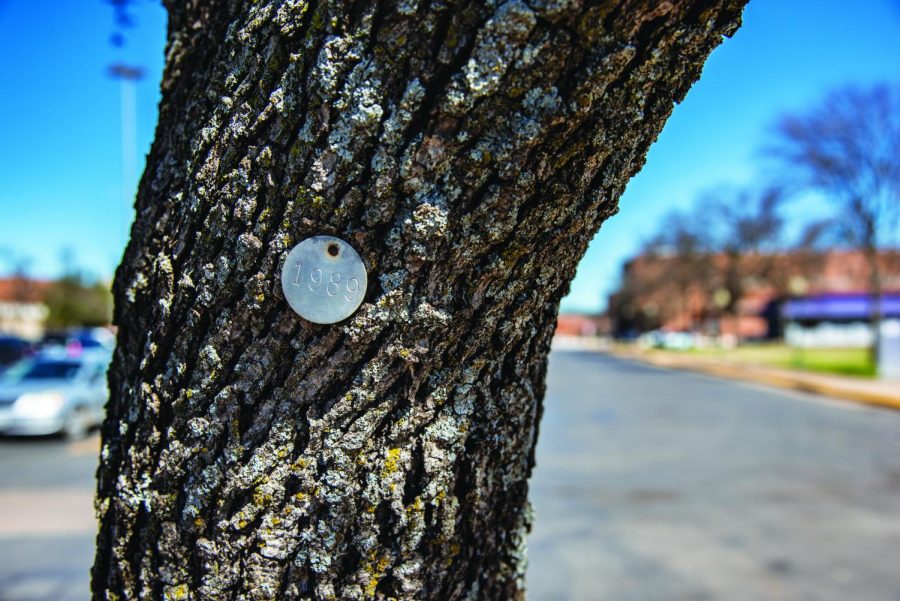Is the oak tree tradition slowly disappearing at Tarleton?
The tree tags are part of a system that allows trees to be identified for maintenance purposes and while some may have the year they were planted, most have a unique number. Also many of the trees are missing tags or are not easily accessible anymore.
Tarleton has many traditions on campus, so many that we even have a book, The Purple Book, to explain all of the traditions.
Some traditions seem to have much more of an impact on students, and that’s why at Duck Camp the Tarleton Transition Mentors (TTM’s) have them as their group names.
One of the most beloved traditions to many students is the oak trees. The oak tree tradition says that Tarleton’s Stephenville campus includes 254 oak trees to represent the 254 counties in Texas.
“Trees have always been an integral part of the Tarleton campus. Today, the official class ring features an oak tree in its design,” the Purple Book said.
Although recently, the trees have been cut down for various reasons.
“I’m a bit bothered by how many trees they’re cutting down,” Omar Herrera, Editor in Chief of the Grassburr, said. “I feel like that is spreading falsehood. They always tell everyone there are 254 oak trees. I feel like there should no longer be a tradition if there isn’t that number of trees.”
In 2017, the oak trees at the Barry B. Thompson Student Center roundabout entrance were cut down due to the grackles starting to infest the trees.
Most recently, the oak trees on the side of the Potishman-Lard Tennis Courts were cut down. This was due to their proximity to the courts themselves.
“We were having issues with leaves, tree debris and bird droppings on the courts. Unfortunately, the trees were planted too close to the facility causing these issues,” David Martin, Assistant Vice President of Campus Operations, said. These were part of the 254 oak trees on campus. Currently there is not a plan to replace the lost oak trees.
“We plan to be more responsible moving forward in terms of how and where we plant trees so that we don’t have these issues. In this particular case, better placement would have helped to avoid losing these trees,” Martin said.
However, they were able to save the oak trees on the east side of the tennis courts. They reduced the trees’ crowns, which is the process of removing branch tips and pruning back to a growth point further down the branch. This was due to the fact they were planted further away from the courts.
Student, Tyler Moore, said, “I am not surprised that they are taking down so many trees, due to the amount of construction that has been done on campus. As much as they have torn down, they don’t have space for all the extra trees.”
The grounds crew has already replaced the lost oak trees. However, instead of planting new oak trees, they have been using different types of trees.

Tarleton has already replaced the oak trees on the west side of the tennis court with Nellie R Stevens holly trees and some additional shrubs around the electrical boxes.
“We have already replaced (the trees) with Nellie R Stevens holly trees and some additional shrubs around the electrical boxes. We utilized as large of replacements as we could readily acquire in order to reduce the impact of the removals,” Martin said.
The Purple Book says, “the center panel (in front of the student center) known as the “tree panel” is a tribute to our benefactor, John Tarleton. The oak tree symbolized how our heritage has grown from a humble beginning with John Tarleton to a university deeply entrenched in spirit and tradition.”
Currently, they are evaluating all of our campus trees and unfortunately they see some need for maintenance –this could result in heavy trimming or possible removal.
“It would be impossible to say there won’t be another situation of trees too close to buildings causing damage or in an unhealthy state requiring removal,” Martin said.
The grounds crew’s goal is to save every tree on campus if possible and start maintaining the trees better moving forward. Their goal is to never remove any tree. However, removal is deemed necessary in some cases.
“I am disappointed, it always seems like a really important tradition on campus,” graduate student, Nyca Kahw, said.
While the goal may be to remove as few trees as possible, it is obvious that the oak trees are still being removed. The reasons for the trees being taken out are understandable, but students feel that Tarleton should stop advertising that there are 254 oak trees if there aren’t.






Kelly Crawford • Feb 28, 2020 at 2:53 PM
There used to be a copious amount of oak trees where the student center is! We used to park between them in a rock parking lot!!
Tim Lashome • Feb 28, 2020 at 1:42 PM
My first memory of Tarleton when I toured the campus in 1983 and the one that has stuck in my mind 37 years later…..
It was a brisk Spring Tuesday morning as I followed the student guide across camps, when all of the sudden I see a dozen or so half sheets of white poster board “nailed” to the trees in what then was the center of campus. They had funny and motivational sayings in them – School Spirit signs. The guide explained “Its a secret organization that sneaks out at night and puts these on the trees”.
Tarleton was the first campus I ever toured and I never set foot on any other campus after that day. I lived the life and the Spirit of Tarleton so much that I was asked to be a member of the oldest organization at Tarleton – the Purple Poo.
Had I not visited Tarleton on an early Tuesday morning…. Had the Poo been disbanded in the early 80’s…. or had those Beautiful oak trees been torn down…. I would not be able to say I am a Proud Alumni of the BEST University ever – Tarleton State University.
Oscar P!!!!
Allan Nelson • Feb 28, 2020 at 12:52 PM
For two decades, I have advocated native plantings on campus in my Plant Taxonomy class and by commenting on the landscaping plan for campus. I have advocated for planting live and post oak trees as well as shrubs like Texas persimmon, Mexican buckeye, Rusty blackhaw, native Salvias, Carolina buckthorn, and Texas redbud. Ground covers like Frog fruit and Horse herb could be used. Plantings of native wildflowers and grasses could be added to beds. Sul Ross State University In Alpine has a beautiful campus that showcases the Chihuahuan Desert ecoregion. Wouldn’t having native landscaping from our ecoregion, the West Cross Timbers, and Lampasas Cut Plain be valuable to our campus? It goes beyond just preserving the 254 oaks (Which suspiciously is also our area code).